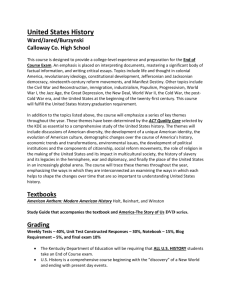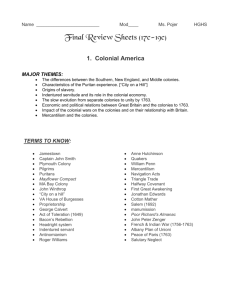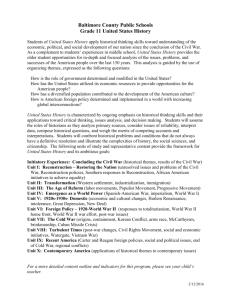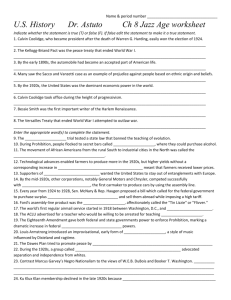APUSH Exam Review Packet - Jefferson County Schools
advertisement
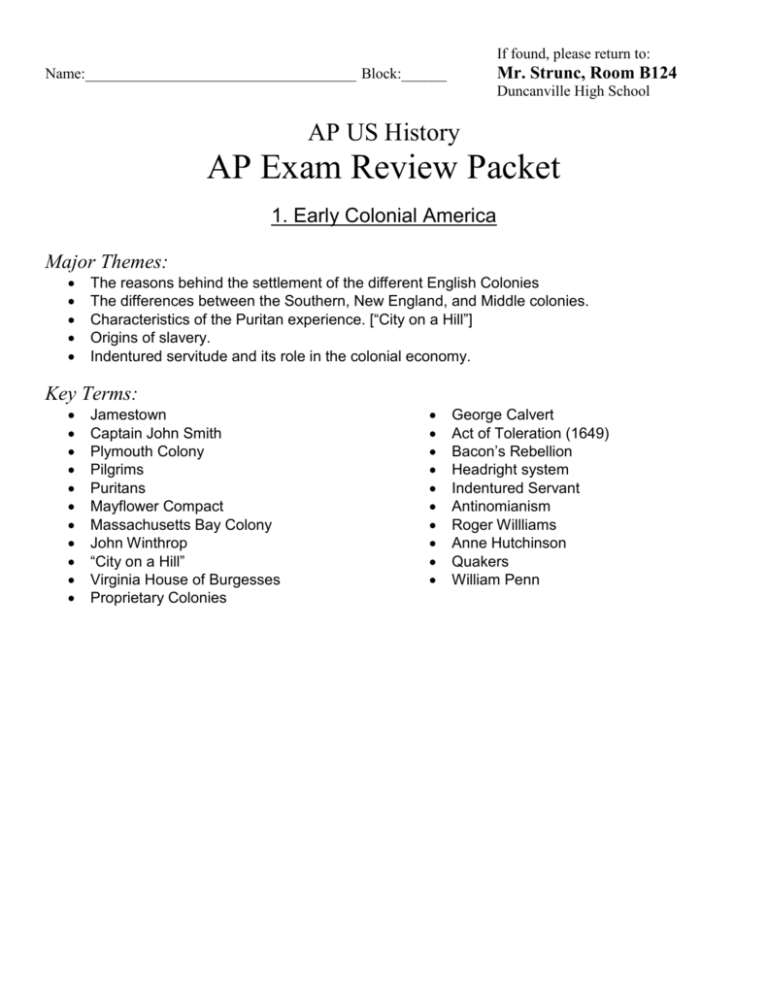
If found, please return to: Mr. Strunc, Room B124 Name:____________________________________ Block:______ Duncanville High School AP US History AP Exam Review Packet 1. Early Colonial America Major Themes: The reasons behind the settlement of the different English Colonies The differences between the Southern, New England, and Middle colonies. Characteristics of the Puritan experience. [“City on a Hill”] Origins of slavery. Indentured servitude and its role in the colonial economy. Key Terms: Jamestown Captain John Smith Plymouth Colony Pilgrims Puritans Mayflower Compact Massachusetts Bay Colony John Winthrop “City on a Hill” Virginia House of Burgesses Proprietary Colonies George Calvert Act of Toleration (1649) Bacon’s Rebellion Headright system Indentured Servant Antinomianism Roger Willliams Anne Hutchinson Quakers William Penn 2. Late Colonial America Major Themes: The impact of social, intellectual, and religious movements on the Colonies [Enlightenment, Great Awakening] The slow evolution from separate colonies to unity by 1763. Economic and political relations between Great Britain and the colonies to 1763. Impact of the colonial wars on the colonies and on their relationship with Britain. Mercantilism and the colonies. Key Terms: Mercantilism Navigation Acts Triangular Trade Halfway Covenant First Great Awakening Jonathan Edwards Cotton Mather Salem (1692) Manumission Poor Richard’s Almanac John Peter Zenger French and Indian War Albany Plan of Union Treaty of Paris (1763) Salutary Neglect 3. Revolutionary America Major Themes: The short- and long-term causes of the American Revolution. Colonial assemblies as leaders against Great Britain. The Revolution was fomented by changes in British colonial policy in the 1763-1776 period. The Revolution was brought on by tight economic controls and loose political controls. The ideas/ideals expressed in the Declaration of Independence. Several different interpretations by historians on the causes of the American Revolution. Was the Treaty of Paris (1783) a victory for the U. S.? How had the 13 separate colonies become similar by the time of the Revolution? The American Revolution as a democratic revolution turned into an aristocratic government by the Constitution. The American Revolution as a question of home rule and who should rule at home. The American Revolution as a revolutionary event consider the economic and social changes associated with the Revolution. Was the Revolution avoidable? Key Terms: Salutary Neglect Proclamation of 1763 Sugar Act (1764) Virtual Representation Stamp Act (1765) Quartering Act (1765) Virginia Resolves Stamp Act Congress Sons of Liberty Writs of Assistance Declaratory Act (1766) Townshend Acts (1767) Sam Adams Boston Massacre Patrick Henry John Dickinson Crispus Attucks Committees of Correspondence Boston Tea Party (1773) Intolerable Acts (Coercive Acts) (1774) Quebec Act (1774) First Continental Congress Lesington and Concord Articles of Confederation Second Continental Congress Common Sense Olive Branch Petition Saratoga French Alliance of 1778 Loyalists (Tories) Yorktown Treaty of Paris 1783 Shays’ Rebellion Annapolis Convention Northwest Ordinance of 1787 4. Constitution and Early Republic Major Themes: Enlightenment concepts and the Constitution. How critical was the “Critical Period”? Compare and contrast the Declaration of Independence, the Articles of Confederation, and the Constitution. Origins of the ideas of separation of powers, written constitutions, and federalism. Areas of agreement at the Constitutional Convention. Bill of Rights: provisions and meanings. Slavery and the Constitution. Failures of the Constitution led to the evolution of political parties. Liberty versus law and order in the 1790s. Hamilton’s economic program. Thomas Jefferson versus Alexander Hamilton. Differences between the Democratic-Republicans and the Federalists. Compare 1763-1776 with 1783-1800 in regard to the relationship between the central government and the colonies or states. Significance of these election years: 1796 & 1800. The “Revolution” of 1800. Loose versus strict construction as a matter of sectional or political interest. The significance of George Washington’s “Farewell Address”. Key Terms: Philadelphia Convention James Madison Alexander Hamilton Virginia Plan New Jersey Plan Connecticut Compromise Three-Fifths Compromise Federalists Antifederalists Strict Construction Loose Construction Federalist Papers (esp. #10, #51) Judiciary Act of 1789 Report on Public Credit (1790) Citizen Genet Jay’s Treaty Whiskey Rebellion Washington’s Farewell Address Democratic-Republican Party XYZ Affair Alien and Sedition Acts Kentucky and Virginina Resolutions “Revolution” of 1800 5. Jeffersonian Era Major Themes: Decline and death of the Federalist Party. “Era of Good Feeling”. Marshall and his Supreme Court decisions. What caused Jeffersonian Democracy to develop? Compare the Second Party System with the First. Rise and development of political parties economic, social, and geographical characteristics and leaders. Hamilton’s economic program created the political issues for the next 50 years. The positions, rationale, issues, and spokesmen for the sections on the following political topics: tariff, banking, internal improvements, expansion, and slavery. The significance of the 1824 election. The War of 1812 as a second War for Independence. Foreign policy united and divided Americans between 1800 and 1824. The interests of the West were satisfied by neither the Jeffersonians nor the Federalists between 1789 and 1815. Provisions and impact of the Monroe Doctrine. Clay’s “American System”. Key Terms: Louisiana Purchase Lewis and Clark Judiciary Act of 1801 “Midnioght Judges” Judicial Review John Marshall Marbury v. Madison (1803) Fletcher v. Peck (1810) McCulloch v. Maryland (1819) Dartmouth College v. Woodward (1819) Cohens v. Virginia (1821) Gibbons v. Ogden (1824) Aaron Burr Embargo Act (1807) Macon’s Bill #2 (1810) War Hawks John C. Calhoun (SC) Henry Clay (KY) War of 1812 Impressment Hartford Convention (1814) Treaty of Ghent (1814) Battle of New Orleans “Era of Good Feeling” Tariff of 1816 Rush-Bagot Agreement (1817) Adams-Onis Treaty (1819) Panic of 1819 Missouri Compromise of 1820 Monroe Doctrine (1823) Erie Canal Robert Fulton Eli Whitney Samuel Slater Lowell System Denmark Vessey (1822) 6. Jacksonian Era Major Themes: What caused Jacksonian Democracy to develop? Immediate and long range consequences of the split between Jackson and Calhoun. Significant elections: 1828, 1832, and 1840. An era of the common man? Sectional tensions: 1800-1840 what were the issues? Key Terms: “Corrupt Bargain” Tariff of Abomination (1828) “Age of the Common Man” “King Andrew” spoils system Peggy Eaton Affair Indian Removal Act (1830) Cherokee Nation v. Georgia (1831) Worcester v. Georgia (1832) “Trail of Tears” nullification Tariff of Abomination Webster-Hayne Debate Proclamation to the People of SC Second Bank of the U. S. Nicholas Biddle Two-Party System “pet banks” Roger Taney Specie Circular “Log Cabin & Cider” campaign “peculiar institution” Nat Turner Panic of 1837 7. Antebellum Reform Major Themes: Transcendentalism: why, what was it, leaders. Reform characterized by perfectionism, distrust of established institutions, and uncompromising impatience. Establishment, philosophy, and failure of Utopian Communities Hudson River Valley School of Painting and a unique American culture [art, literature, education] Compare the First and Second Great Awakenings. Strengths and weaknesses of democracy as illustrated by abolitionism and the women’s movement. Key Terms: Second Great Awakening Mormons Joseph Smith Brigham Young Romanticism Transcendentalism Ralph Waldo Emerson Henry David Thoreau Brook Farm Shakers Oneida Community Joseph Henry Noyes Thomas Cole Frederick Church Hudson River School Washington Irving James Fennimore Cooper Nathanial Hawthorne Temperance Dorothea Dix Horace Mann McGuffey Reader Grimke Sisters Lucretia Mott Elizabeth Cady Stanton Seneca Falls Convention (1848) Susan B. Anthony William Lloyd Garrison The Liberator Frederick Douglass Harriet Tubman Sojourner Truth David Walker Amelia Bloomer 8. Manifest Destiny and Sectionalism Major Themes: Principles that caused territorial expansion between 1815 and 1860. Trace sectionalism from 1810-1850 through the careers of Clay, Calhoun, and Webster. Manifest Destiny and the road to war. Impact of Manifest Destiny on both foreign affairs and domestic politics. Why was Oregon annexed peacefully, but not Texas? Southern arguments defending slavery; abolitionist counterarguments and institutions Slavery from the viewpoint of the slave, the slaveholder, and the non-slaveholding white Southerner. The issue of slavery in the territories. Slavery as a threat to white Northern labor. Compare the black struggle to achieve freedom with the abolitionist struggle to free slaves. Blacks in the North: 1790-1860. William Lloyd Garrisonhero or villain of the antislavery movement. Key Terms: Whigs Manifest Destiny Stephen Austin Sam Houston Santa Ana Webster-Ashburton Treaty (1842) Gold Rush Samuel F. B. Morse Compromise of 1850 Fugitive Slave Law Underground Railroad Harriet Beecher Stowe Hinton R. Helper George Fitzhugh Kansas-Nebraska Act (1854) Know-Nothings Commodore Matthew Perry (1853) o 54 40’ Or Fight! Mexican War (1846-1848) John C. Fremont Treaty of Guadelupe-Hidalgo (1848) Wilmot Proviso Free Soilers Clayton-Bulwer Treaty (1850) Gadsden Purchase (1853) Popular sovereignty “Bleeding Kansas” John Brown Harper’s Ferry, VA Sumner-Brooks Dred Scott v. Sanford (1857) Lincoln-Douglas Debates (1858) A House Divided Freeport Doctrine Crittenden Compromise (1860) 9. Civil War and Reconstruction Major Themes: The Civil War began with the Mexican War!? Northerners objected not to slaves but to the political and economic power and influence slavery gave the slaveholder in the national government. Event, person, or place as a symbol of North-South division, such as Bleeding Kansas, John Brown, or the Crittenden Compromise. Southern grievances against the North. North-South economic differences before the Civil War that continued unresolved after it. The 1850sa decade of political sectionalism and economic nationalism. Role of the Supreme Court in the Civil War and Reconstruction. Breakdown of both the Whig and Democratic parties in the 1850s and rise of the third party system. Struggle between the president and Congress for dominant political power within the federal government, 1850-1868. States’ rights from 1790-1860 for all the sections. Civil War triumph of American democracy over European aristocracy (“slaveocracy”). When did the Civil War become inevitable and why? What causes of the Civil War were resolved by the Civil War and Reconstruction? Was the Republican Party consistent in its policies from the 1850s to 1877? The issues of the Civil War were similar to those of the American Revolution. Accomplishments and failures of Reconstruction. Compare the social and political gains made by Blacks during Reconstruction with those during the second Reconstruction, and during the 1950s and 1960s. Major developments in the history of Blacks between 1865 and 1912. Key Terms: Fort Sumter Jefferson Davis Bull Run (I & II) Anaconda Plan George McClellan Antietam Merrimac & Monitor Gettysburg th 13 Amendment Emancipation Proclamation (1863) Sherman’s “March to the Sea” Appomattox ex parte Merriman Copperheads Greenbacks Morrill Tariff Act (1861) Homestead Act (1862) Morrill Land Grant Act (1862) Ex Parte Milligan 10% Plan Presidential Reconstruction Wade-Davis Bill (1864) Sherman’s Field Order #15 Freedman’s Bureau Black Codes Radical (Congressional) Reconstruction Civil Rights Act (1866) th 14 Amendment th 15 Amendment Tenure of Office Act (1867) Scalawag Carpetbagger Crop lien system “Waving the Bloody Shirt” Credit Mobilier Panic of 1873 (“Crime of ‘73”) Redeemers KKK Compromise of 1877 10. The West and the New South Major Themes: Why was the Great Plains settled last? What brought a speedy end to the frontier? Economic and political consequences of the closing of the frontier. Theories of Frederick Jackson Turner The “myth” of the frontier in American culture and how did it influence American character? Evolution of federal land policy toward Indians to 1924. Farmers versus the railroads and industry. Southern whites reestablished political control after Reconstruction and modernized the Southern economy. Rise of Jim Crow laws. Booker T. Washington versus W. E. B. DuBois. Populism urged political solutions to economic problems. Why did Populism fail, or did it? Problems facing farmers. Compare and contrast the Grange, the Farmers’ Alliance, and Populism. Connect Southern Populism and the rise of racism. Key Terms: Sand Creek Massacre (1864) Chinese Exclusion Act (1882) Frederick Jackson Turner George A. Custer Little Big Horn Chief Joseph Helen Hunt Jackson Plessy v. Ferguson (1896) Grandfather clause Ida B. Wells Booker T. Washington W. E. B. DuBois Granger Laws Munn v. Illinois (1876) Dawes Severalty Act (1887) Ghost Dance Wounded Knee George Washington Carver Tuskegee Institute Jim Crow Civil Rights Cases of 1883 Interstate Commerce Act (1886) National Alliance Populism Ocala Platform Dear money Soft money William Jennings Bryan “Cross of Gold” 11. Big Businesses, Labor, Urbanization Major Themes: Changes in the economy from 1865-1900 in transportation, agriculture, labor force, and industry. Rise of corporations, trusts, pools, and holding companies. Factors that promoted industrialization. Trace shifting Supreme Court decisions in regard to the regulation of railroads and industry. This period as one of governmental intervention in the economy, NOT of laissez-faire. The role and significance of technological innovations. Characteristics of different labor unions NLU, Knights of Labor, AFL, ARU—differences, successes, failures, leaders, reasons for directions they took. Changing workplace conditions wages, hours, safety. Compare and contrast the Haymarket Square riot, the Homestead strike, and the Pullman strike. Attitude of government, state and federal, toward labor unions to 1914. Key Terms: Gilded Age Robber Barons Cornelius Vanderbilt Jay Gould Andrew Carnegie John D. Rockefeller Sherman Antitrust Act (1890) U. S. v. E. C. Knight (1890) Social Darwinism Gospel of Wealth Thomas A. Edison Horatio Alger Yellow-dog contract Open shop Closed shop Railroad Strike of 1877 Knights of Labor Haymarket Riot (1886) AFL Samuel Gompers Homestead Strike (1892) Pullman Strike (1894) In Re Debs 12. Urbanization and Politics Major Themes: Compare and contrast the Democratic and Republican Parties: base of support, policies, successes, etc. The 1890s as a decade of economic, political, and social crises. Explain the location and growth of the post-Civil War cities. Rise of speactator sports. Gilded Age as an era of “conspicuous consumption” [Thorstein Veblen’s phrase]. Reformers’ attempts to address problems of poverty, housing, and health. Municipal governments why were they so bad? Why so frustrating to reformers? Women’s Movement: 1848-1920. Churches’ attack on social and economic problems. The Social Gospel as a religious movement. Darwinism and church leaders. Reactions to immigration: pre-Civil War versus Civil War to 1920s. Urbanization reflected in art and literature. Compare and contrast Henry George and Edward Bellamy. Compare and contrast the treatment of immigrants, Blacks, and Indians during this post-Civil War era. Key Terms: Boss Tweed Thomas Nast Henry George Jacob Riis Edward Bellamy Settlement Movement Jane Addams Social Gospel Carry Nation Louis Sullivan Chicago School of Architecture William Lloyd Wright “Melting Pot” theory Emma Lazarus Pendleton Act (1885) Bland-Allison Act (1878) Sherman Silver Purchase Act (1890) Panic of 1893 Coxey’s Army Mark Hanna Silver bugs Gold bugs 13. Imperialism Major Themes: Organize U. S. foreign policy from 1870-1920 by: (1) geographic regionFar East, Latin America, Caribbean, Europe; (2) American motiveseconomic, moral, Monroe Doctrine, balance of power among European nations, dominance in the Caribbean; (3) influence of domestic policies on foreign policy. Imperialism: characteristics, sources, nature, causes, impact, results, compared to European imperialism. LinkReconstruction, Populism, and Imperialism. Compare and contrast the old and the new Manifest Destiny. Roosevelt’s foreign policy. Wilson’s foreign policy. U. S. policy toward Mexico and Cuba, 1890s-1930s. Key Terms: Treaty of Kanagawa “Seward’s Folly” Alfred Thayer Mahan Jingoism Yellow journalism William Randolph Hearst Spanish-American War (1898) De Lome Letter Remember the Maine, to Hell with Spain! Teller Amendment Rough Riders Queen Liliukalani George Dewey Walter Reed Emilio Aguinaldo Treaty of Paris 1898 “White Man’s Burden” Anti-Imperialist League Insular Cases Platt Amendment Open Door Policy Boxer Rebellion “Big Stick” policy Roosevelt Corollary Protectorate Clayton-Bulwer Treaty Pan-Americanism John Hay Panama Canal Gentleman’s Agreement Treaty of Portsmouth (1905) Great White Fleet “Dollar Diplomacy” Henry Cabot Lodge, Sr. Jones Act (1916, 1917) “Moral Diplomacy” Tampico Incident Pancho Villa John J. Pershing “Colossus of the North 14. Progressive Era Major Themes: Compare and contrast the Populist and Progressive movements. Compare Progressivism and Jacksonianism. Goals of Progressivism: successes, failures. Progressives as the new Federalists: Compare Hamilton’s program and Progressivism. Progressivism as the “have-nots” against the “haves”: role of labor unions, immigrants, Blacks, women, and urban poor. Corporations and unions both wanted governmental protection but not governmental regulation. Trace the regulation of big business and court interpretations from the Interstate Commerce Act to U. S. v. U. S. Steel Corp. in 1920. Trace the long history of a reform such as prohibition, women’s rights, or banking. Supreme Court interpretations and changing economic and social conditions, 1890-1920. Significant elections: 1900, 1912, 1920. Compare and contrast the programs and administrations of Theodore Roosevelt, Woodrow Wilson, and William Howard Taft: banking, railroads, trusts, tariffs, etc. Progressivism a liberal or conservative movement? War and the threat of war united and divided Americans in the 1898-1920s period. Key Terms: Muckrakers Jacob Riis [How the Other Half Lives] Thorstein Veblen [The Theory of the Leisure Class] Lincoln Steffens [The Shame of the Cities] Frank Norris [The Octopus] Ida Tarbell [History of Standard Oil Co.] John Dewey [The School and Society] Margaret Sanger 16th, 17th, 18th, 19th Amendments Triangle Shirtwaist Co. fire Anti-Saloon League Square Deal Newlands Reclamation Act (1902) Forest Reserve Act (1891) Anthracite Coal Strike (1902) Hepburn Act (1906) “Trustbuster” Meat Inspection Act Upton Sinclair [The Jungle] Pure Food and Drug Act Panic of 1907 Wisconsin, “Laboratory of Democracy” Bob LaFollette Ballinger-Pinchot controversy Bull Moose Party Roosevelt’s Osawatomie, KS speech New Freedom New Nationalism Socialist Party IWW [“Wobblies”] “Big Bill” Haywood - Federal Reserve Act (1913) Underwood-Simmons Tariff 15. World War I and the Roaring Twenties Major Themes: Causes of U. S. entry into World War I and its attempts to remain neutral. World War I both helped and hurt Blacks and labor. Compare the domestic impact of the First and Second World Wars. Defeat of the Versailles Treaty: immediate and long-term consequences. Harding and the 1920s as the end of Progressivism. What aspects of Progressivism survived into the 1920s? Were the 1920s “golden” or “roaring” for farmers, labor, and business? Coolidge: The man who builds a factory builds a temple; the man who works there worships there. The 1920s as an age of nonconformity: Blacks, feminists, literary criticism, new sexual freedoms. The dark side of the 1920s: anti-immigration, KKK, Scopes Trial, prohibition. Alienation as a literary them in the 1920s F. Scott Fitzgerald’s Great Gatsby [the “Lost Generation”]. Key Terms: “Return to Normalcy” Teapot Dome Scandal Muscle Shoals Secy. of the Treasury Mellon (tax cuts) Election of 1924 Progressive Party Federal Farm Board “The Lost Generation” Theodore Dreiser [An American Tragedy] Ernest Hemingway [A Farewell to Arms] T. S. Eliot [The Waste Land] prohibition [Volstead Act] fundamentalists Immigration Acts (1921, 1924) Billy Sunday Scopes Trial Henry Ford [Model T] The Jazz Singer [1st talking movie] flappers the “New Woman” Harlem Renaissance Langston Hughes Marcus Garvey Pan-African movement Charles Lindbergh “Spirit of St. Louis” Twenty-One Demands Washington Naval Conference 5:5:3:1.75:1.75 naval ratio Dawes Plan Young Plan Kellogg-Briand Treaty Triple Entente Triple Alliance Central Powers Lusitania Zimmermann Note War Industries Board Herbert Hoover, Food Administration Espionage Act (1917) Sedition Act (1918) selective service Fourteen Points Versailles Treaty Big Four collective security Senator Henry Cabot Lodge Red Scare Palmer raids 16. Depression and New Deal Major Themes: Causes of the Great Depression. Compare the criticisms of American society writers made in the 1920s with those made in the 1930s. Compare Hoover’s and FDR’s response to the Depression. Compare the role of the federal government in the economies of the 1920s and 1930s. The twenties were pro-business; the thirties were anti-business. Compare Progressivism and the New Deal. Compare and contrast the First and Second New Deals. Different characterizations of the New Deal: it was socialistic, conservative, revolutionary, liberal Successes and failures of the New Deal. The Supreme Court and the New Deal. Impact of various New Deal programs and agencies on American society. Rise of the welfare state. Big government and big labor checked big business. Explain the critics of the New Deal: Townsend, Coughlin, Huey Long, leftists, conservatives. What ended the reform effort by the late 1930s? Reform would have come without a depression because reform in American history is the periodic readjustment of aspects of the economy. Compare the labor movement of the 1930s with the labor movement of the late 19c. Why did the Socialist Party fail to become a serious factor in American politics? Key Terms: Smoot-Hawley Tariff (1930) Reconstruction Finance Corporation (RFC) Bonus Army “Hoovervilles” Good Neighbor Policy Norris-LaGuardia Act (1932) election of 1932 20th & 21st Amendments bank holiday Hundred Days Emergency Banking Relief Act (1933) “Relief, Recovery, Reform!” Glass-Steagall Banking Reform Act (1933) Federal Deposit Insurance Corp. (FDIC) National Industrial Recovery Act (NIRA) National Recovery Administration (NRA) the “Blue Eagle” Agricultural Adjustment Act (AAA) Civilian Conservation Corps (CCC) Federal Emergency Relief Admin. (FERA) Civil Works Administration (CWA) Public Works Administration (PWA) Works Progress Administration (WPA) Harry Hopkins Federal Arts Project Home Owners’ Loan Corporation (HOLC) Federal Housing Authority (FHA) Securities and Exchange Commission (SEC) Joseph Kennedy, Sr. Tennessee Valley Authority (TVA) Rural Electrification Administration (REA) National Youth Administraiton (NYA) Indian Reorganization Act (1934) Wagner Act (1935) National Labor Relations Board (NLRB) Fair Labor Standards Act Congress of Industrial Organization (CIO) John L. Lewis Dust Bowl Oakies John Steinbeck [The Grapes of Wrath] Frances Perkins, Secy. of Labor Eleanor Roosevelt Keynesian economics Huey Long [the “Kingfish”] “Share the Weath” Father Charles Coughlin Election of 1936 Social Security Act Schechter v. US “Court Packing” Chief Justice Charles Evans Hughes Hatch Act (1939) 17. World War II Major Themes: Compare isolationism after World War I with leadership of the Western world after World War II. What were the causes of World War II up to 1939 Events leading to US involvement in WWII Effects of WWII on American society and economics Manhattan Project and the reasons to use the Atomic Bomb Results of Yalta and Potsdam Conferences Key Terms: Montevideo Conference Rio de Janeiro Conference (1933) Buenos Aires Conference (1936) Lima Conference (1938) Spanish Civil War (1936-1939) Francisco Franco Adolph Hitler Benito Mussolini Joseph Stalin Chiang Kai-shek Panay Incident General Tojo Lend Lease Atlantic Charter (1941) Pearl Harbor (12/7/41) War Production Board Office of Price Administraiton (OPA) genocide Holocaust “Final Solution” D-Day (6/4/44) Stalingrad Winston Churchill Casablanca Conference (1943) Teheran Conference (1943) “unconditional surrender” Battle of the Bulge Manhattan Project J. Robert Oppenheimer Hiroshima Nagasaki V-E Day V-J Day Manzinar Relocation Korematsu v. US Yalta Conference Potsdam Conference Churchill’s “Iron Curtain” speech Bretton Woods Conference Dunbarton Oaks Conference UN Charter Nuremberg trials 18. Post WWII and The 1950s Major Themes: Compare and contrast American foreign policy in the 1920s and 1930s with American foreign policy in the fifteen years after World War II. The impact of communism upon both foreign and domestic affairs in the two decades after World War II. Was the Cold War inevitable? Compare and contrast the foreign policies of Truman and Eisenhower. How consistent was U. S. policy toward China from 1900-1949? Impact of the Spanish-American War, World War I, and World War II on our commitments and security in Asia and the Pacific Ocean. American foreign policy from 1945-1960 was controlled by the ghost of Woodrow Wilson. Social, economic, and demographic changes within the United States (1945-1960) Key Terms: Voice of America Marshall Tito containment George F. Kennan Truman Doctrine Marshall Plan Berlin Blockade NATO Warsaw Pact SEATO CENTO ANZUS collective security Mao Tse-tung Korean War General Douglas MacArthur Gandhi Bricker Amendment John Foster Dulles mutual assured desgtruction (M.A.D.) brinksmanship Nikita Khrushchev Hungarian Revolt (1956) Common Market Organization of American States (OAS) U-2 Incident G. I. Bill of Rights (1944) Baby Boom Youth culture Taft-Hartley Act Senator Robert A. Taft Dixiecrats Senator Strom Thurmond Henry Wallace Fair Deal National Security Act (1947, 1949) McCarthyism Senator Joseph McCarthy Alger Hiss Julius and Ethel Rosenberg McCarran Internal Security Act (1950) 22nd Amendment Ayn Rand [The Fountainhead] McCarran-Walter Immigration Act (1952) Interstate Highway Act Dept. of Health, Educ. & Welfare (HEW) St. Lawrence Seaway Jimmy Hoffa AFL-CIO merger Sputnik National Defense Education Act (NDEA) “military-industrial complex” 19. The Civil Rights Movement (1950s-1970s) Major Themes: Supreme Court ruling against segregation and placement of constitutional authority over desegregation Leaders who advocated use of nonviolent protest through the 50s and 60s Federal actions attempting to protesct individuals’ civil rights, including Executive actions and Congressional legislation Emergence of the militant black protests of the mid-60s, 70s Movement of debate from civil rivghts to economic equality Compare and contrast the experiences of various groups—labor, Blacks, business, farmers— following the First and Second World Wars. Disputes among black leaders over goals, methods, and the degree of integration. 1950s as an era of social anxiety. Reasons for and consequences of black migration from the rural South to the urban North in the 20c. Key Terms: Plessy v. Ferguson Jim Crow System Brown v. Board of Education desegregation “Separate But Equal” Thurgood Marshall Rosa Parks Montgomery Bus Boycott Rev. Martin Luther King, Jr. Little Rock, AR Central High School Civil Rights Act (1957) Civil Rights Act (1960) Greensboro, NC sit-ins Student Nonviolent Coordinating Committee [SNCC] Southern Christian Leadership Conference [SCLC] Congress of Racial Equality [CORE] Freedom Riders Birmingham Church Bombing March on Washington (1963) poll taxes Mississippi Freedom Summer Civil Rights Act of 1964 Nation of Islam Elijah Muhammad Malcolm X Black Panthers March form Selma to Montgomery James Meredith Voting Rights Act of 1965 Stokely Carmichael Watts Riots Civil Rights Act of 1968 24th Amendment George Wallace for President Affirmative Action Regents v. Bakke (1978) 20. The Sixties and Seventies Major Themes: Significance of the Election of 1960 Explain and evaluate the goals of the New Frontier and the Great Society and their successes and failures Modification of American foreign policy to confront perceived communist aggression Impact of Vietnam of American society, culture, economy, and politics Supreme Court cases involving issues of individual rights, power of government, rights of the accused Moderate and conservative policies of the Nixon Administration in foreign and domestic affairs Growth and significance of the counterculture movement in the United States. Impact of the Watergate scandal on American society Stagflation and the inability of three Presidents (Nixon, Ford, Carter) to effectively deal with it Emphasis of Human Rights in Carter’s foreign policy and their effects Key Terms: Bay of Pigs Berlin Wall Alliance for Progress Cuban Missile Crisis ICBM Ich bin ein Berliner Great Society Medicare/Medicaid VISTA Dien Bien Phu Ho Chi Minh Domino theory Ngo Dinh Diem Viet Cong Gulf of Tonkin Resolution Hawks and doves Agent Orange Tet Offensive My Lai Massacre Vietnamization Cambodia Kent State Pentagon Papers War Powers Act 26th Amendment Saigon (1975) Hippies Students for a Democratic Society Woodstock Betty Friedan Gloria Steinem Phyllis Schlafly Warren Court Miranda v. Arizona Assassinations of 1968 Apollo Program Rachel Carson National Organization for Women (NOW) Equal Rights Amendment (ERA) American Indian Movement (AIM) Caesar Chavez United Farm Workers Strategic Arms Limitation Treaty (SALT) Henry Kissinger Détente Watergate Gerald Ford Roe v. Wade Arab Oil Embargo Organization of Petroleum Exporting Countries (OPEC) Camp David Accords Panama Canal Treaty Three Mile Island Afghanistan (1979) Ayatollah Khomeini Iran Hostage crisis 21. 1980 to Present Major Themes: Resurgance of conservatism in the election of Ronald Reagan Reagan’s stance against the Soviet Union, compared with his willingness to foster better relations Reasosn for American victory in the Cold War Collapse of the Soviet Union, end of the Cold War, and the impact on fAmerican domestic and foreign policies Causes and consequences of Operation Desert Storm Transformation of American Society, especially due to rapid advances in technology Domestic agenda of Bill Clinton’s administration and his legacy Controversy surrounding the Election of 2000 Foreign Policy aims of George W. Bush’s administration Polarization of the American electorate Election of Barack Obama (2008) Key Terms: Ronald Reagan Moral Majority Lebanon Grenada Strategic Defense Initiative, aka “Star Wars” Libya (1986) Sandra Day O’Connor Geraldine Ferraro Iran-Contra Scandal Supply-side economics Mikhail Gorbachev Chernobyl AIDS Savings and Loan Crisis (1989) George H. W. Bush Tiananmen Square Manuel Noriega Fall of Berlin Wall Los Angeles Riots (1992) Bill Clinton North American Free Trade Agreement (NAFTA) Contract with America Newt Gingrich Oklahoma City Bombing Madeline Albright Al Gore George W. Bush September 11, 2001 Invasion of Iraq (2003) John McCain Barack Obama Hillary Clinton Stimulus Package Health Care Reform Bill Mid-Term Elections of 2010
